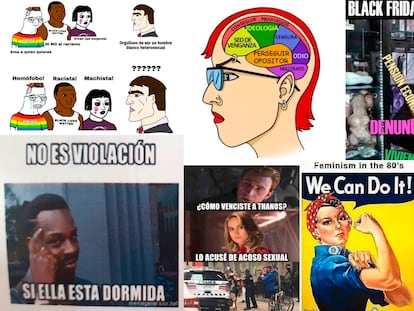Corecore is the internet’s new Dadaist anti-trend: Desperate men in search of solace
TikTok accounts in this category have racked up millions of views; they are designed to provoke feelings of anguish and desolation in viewers, especially among frustrated young people

There may be more sophisticated ways to let oneself fall into despair than spending an entire afternoon watching Corecore on your cell phone, but few of them are more specific to our times. Segments of Generation Z (those born after 1995) construct their identity on TikTok. This social media platform employs thousands of tags with which users define both online content and themselves. Corecore, which has already racked up two billion views, is one of them, though it does not often resemble any of them. Loneliness and existential angst are the words that best describe this internet-based community. Most strikingly, these creations — which for some are an artistic genre unto themselves — are riddled with anti-capitalist messages that decry the alienating and dehumanizing aspects of social media. TikTok’s algorithm has emerged from a trend, in which young people have found an unexpected ally.
Urban Dictionary defines Corecore as “kind of a deconstructed art, basically invoking emotion out of a series of (visual) clips that you develop your own meaning [for]. Corecore content is introspective.” No one knows for sure how this trend originated. Various publications cite a video collage by user @masonoelle from January 2021 as one of the first examples of Corecore’s impact on social media. John Rising, known on TikTok as @HighEnquiries, is considered one of the genre’s creators. In an interview with Vice, he explained, “I’ve never really felt a need to give it a name, I was just trying to make videos that evoked some sort of reaction in people.”
Corecore’s videos last for about a minute, and they are addictive. They consist of visual montages created from scenes from around the Internet; anything goes — movies, rehashed memes, viral videos, news clips and snippets of other TikTok posts. Nearly every one of them is accompanied by a melancholic soundtrack. Because Corecore’s intention is to represent society’s emptiness and absurdity, some media have compared it to the Dadaist art of the early twentieth century. Corecore and dadaism also coincide in their chaotic, anti-aesthetic structure. However, the works of the Tristan Tzara-led movement were given to chance. In contrast, Corecore has an intelligible discourse and repeating patterns: loneliness, depression, consumerism, global warming, social media toxicity and the inability to establish human connection. In short, Corecore seeks to elevate feelings but through an overarching theme.
@metallicasoundgarden quiet desperation #nichetok #corecore
♬ QKThr - Aphex Twin
The precise origin of the term Corecore is unclear. According to the website Know Your Meme, the word was first used on Tumblr in 2020. The noun is a metalinguistic word play on the suffix “-core,” which internet culture uses to define an aesthetic. For example, there’s cottagecore (aesthetics associated with the countryside, nature and tradition); witchcore (aesthetics based on a fondness for the world of magic); and normcore (aesthetics related to wearing basic, unpretentious attire). Users, brands and the social media website itself pay attention to identifying the latest aesthetic trends on TikTok. It is important to understand that the word “aesthetics,” which began as a discipline of philosophy that studies the nature of beauty, has acquired a new meaning in recent years. Saying that something is aesthetic came to mean that we like something “aesthetically.” The term’s meaning continued to expand, and, as Moises Mendez explains in a Time magazine article, it “has [now] become a catch-all term for Gen Z, encompassing moods, feelings, and subcultures around which people can find like-minded users online. The niche-ification of the platform has carved out small corners of the Internet for seemingly every special interest, mood, hobby, like, dislike, and, yes, aesthetic.”
An aesthetic is also a community
“Generation Z uses TikTok to construct its identity,” says Alvaro L. Pajares, a TikTokker and editor of the book Memeceno: La era del meme en internet (The Internet’s Meme Era). He sees that phenomenon at work in each community or aesthetic that has the “-core” suffix. “Until now, no platform had managed to offer the user such a specific and personalized experience for their reality. It does this by creating microcells or micro-niches that reflect a specific aesthetic and identity,” Pajares explains. “The novelty of TikTok, as compared to other platforms, is that each user has a feed based on the content they consume, not the people they follow,” he notes. “It’s the first social network that 100 percent understands that it’s no longer about networking… The business is in keeping people watching and creating content,” he observes.
Using labels to define ourselves isn’t new. “Having a self-described ‘aesthetic’ has been an online trend since the days of early 2010s Tumblr blogs; however, the parameters of these new forms of stylistic appearances have become increasingly precise and intertwined with one’s lifestyle,” writer Madison Huizinga says in her essay “On Feeling Pretty When You Cry: ‘Cottagecore,’ ‘That Girl’ & Self-Aestheticization.” She argues that TikTok has led to a rise in niche internet aesthetics. “Never before had I seen such enthusiasm for categorizing certain lifestyle choices to fit such detailed online definitions,” she asserts. “There is clear comfort in feeling as though one’s interests, hobbies, and aspirations are shared by others. And the Internet provides excellent forums for individuals to reach people outside their physical communities that have similar passions.”
@uzfye Real #corecore #nichetok #debut #jakegyllenhaal #ryangosling #sad #edit
♬ original sound - 𝘶𝘻
“Corecore is the anti-aesthetics of TikTok,” says Pajares. They are “Generation Z’s black sheep who can’t find their place [anywhere],” he continues. For example, he compares the Corecore consumer to “a kid who is sitting on a bench in the mall and doesn’t want to go into any store to shop.” Several authors have spoken of the mercantilist trap behind the rise of niche internet. As Joana Girona, a journalist who specializes in digital culture, states in an article published by the Center of Contemporary Culture of Barcelona: “The increase of all these aesthetics directly implies a benefit for digital capitalism, which commercializes and exploits our online habits and tries to sell or create the need for us to have a certain product, as it has always done, but now [it is doing it] in a more massive and perverse way.” Essayist Rayne Fisher-Quann says it even more forcefully: “Everyone is jostling for attention in a crowded room, struggling to differentiate themselves within an algorithm that exists to turn their personhood into a commodity.”
Lone wolves
“Lately, Corecore is the only thing that makes me feel real,” user Jett comments on a video under the tag Corecore. “I hear you, bro,” replies king-manny, who is not alone sharing this sentiment. Corecore is a community of those who feel alone in an increasingly connected world. “That’s why references to scroll down [scrolling up and down on the cell phone], addiction and seeing empty content are so recurrent,” Pajares explains.
Loneliness — and the mental health problems that stem from it — is one of the great epidemics of our time. The coronavirus crisis led to a 25% increase in the number of people suffering from anxiety and depression. TikTok’s algorithm seems to have shaped this despair. In a Hyperallergic article, journalist Isabella Segalovich expressed concern that “these viral videos can draw those of us (like myself) who struggle with anxiety and depression into deeper despair.” Moreover, “desperation has left increasing numbers of men susceptible to manipulation by right-wing opportunists. Joe Rogan, Jordan Peterson, and Theo Von make frequent appearances in corecore videos.” The columnist notes that these characters are often paired with “lonely, angry, and sometimes violent male protagonists from blockbusters like American Psycho, Blade Runner 2049, Fight Club, and The Joker.”
“There are overlapping identities or labels,” explains Pajares, who cites the concept of the sigma male to explain this dimension of Corecore. “It’s an alternative version of the alpha male within the manosphere [anti-feminist Internet forums],” he says. According to the expert, sigma males have concluded that there are two types of men in gendered relationships: alpha males, who need to constantly reaffirm their position in the group; and beta males, who are unable to sustain that attention. “After reading people like Jordan Peterson, the sigma male realizes that his power lies in not needing external validation, being emotionally autonomous, and being able to lead a solitary life.”
Figures like Patrick Bateman, the protagonist of American Psycho (2000), and Ryan Gosling’s character in Blade Runner 2049 (2017) are frequently the models for this type of masculinity. “This is a masculinity that might be considered toxic; although it has a conception of gender roles, it has had to deconstruct itself through Jordan Peterson’s discourse,” Pajares argues. “Corecore doesn’t have to be negative, but the seed of it is there. Hatred of TikTok is also hatred of the lonely man, who asserts his own autonomy even though he would really like to get attention, just like everyone else.”
Sign up for our weekly newsletter to get more English-language news coverage from EL PAÍS USA Edition
Tu suscripción se está usando en otro dispositivo
¿Quieres añadir otro usuario a tu suscripción?
Si continúas leyendo en este dispositivo, no se podrá leer en el otro.
FlechaTu suscripción se está usando en otro dispositivo y solo puedes acceder a EL PAÍS desde un dispositivo a la vez.
Si quieres compartir tu cuenta, cambia tu suscripción a la modalidad Premium, así podrás añadir otro usuario. Cada uno accederá con su propia cuenta de email, lo que os permitirá personalizar vuestra experiencia en EL PAÍS.
¿Tienes una suscripción de empresa? Accede aquí para contratar más cuentas.
En el caso de no saber quién está usando tu cuenta, te recomendamos cambiar tu contraseña aquí.
Si decides continuar compartiendo tu cuenta, este mensaje se mostrará en tu dispositivo y en el de la otra persona que está usando tu cuenta de forma indefinida, afectando a tu experiencia de lectura. Puedes consultar aquí los términos y condiciones de la suscripción digital.
More information
Archived In
Últimas noticias
Most viewed
- Reinhard Genzel, Nobel laureate in physics: ‘One-minute videos will never give you the truth’
- Oona Chaplin: ‘I told James Cameron that I was living in a treehouse and starting a permaculture project with a friend’
- Pablo Escobar’s hippos: A serious environmental problem, 40 years on
- Chevy Chase, the beloved comedian who was a monster off camera: ‘Not everyone hated him, just the people who’ve worked with him’
- Why we lost the habit of sleeping in two segments and how that changed our sense of time











































